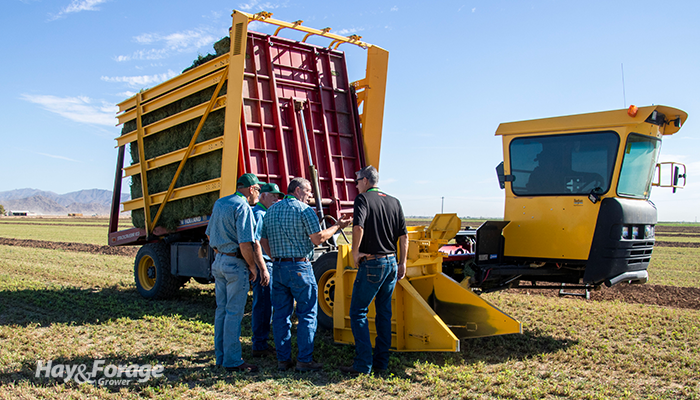
How does your brain work? Are you of the analytical ilk or are you more of a creative thinker? Do you articulate your thoughts in words or would you rather work with numbers? Temple Grandin, for one, thinks in pictures.
This unique ability led Grandin to develop cattle handling techniques and design animal handling facilities that are used in major meat packing plants around the world. She has a capacity for visual thinking that lends itself to tremendous troubleshooting skills and a knack for problem-solving. Even so, the brilliant livestock welfare expert with a doctorate in animal science admits she can’t do basic algebra.
The dichotomy between visual thinking and higher math was the basis of her presentation titled, “The World Needs All Kinds of Minds,” that she gave at the National Hay Association (NHA) Convention last month in Scottsdale, Ariz. In addition to object visualizers, Grandin described two other kinds of minds as spatial visualizers and verbal thinkers — all of which are critical to the small-scale farm scene, as well as the hay industry at large.
Object visualizers, like Grandin, think in pictures, making them excellent designers and mechanics. Spatial visualizers think in numbers and patterns — these are the engineers, mathematicians, and chemists of the world. Verbal thinkers include writers, teachers, and psychologists — and politicians, Grandin quipped.
While most people possess a combination of the three kinds of minds and resonate with the one that has a slightly stronger pull, Grandin explained she sits at the extreme end of the object visualization. As a renowned autism spokesperson and someone with autism herself, she emphasized how her intellectual abilities shaped her career in the livestock industry. She even boasted her own brain scans to show the audience that her visual cortex is much larger than the average human’s.
While a bigger brain might not be the defining characteristic of some haymakers, object visualization is an obvious strength of many. That is especially apparent in those who challenge the status quo by inventing baling equipment or adapting practices to streamline their production systems.
Visualizing an invention
Small square bales are — and likely will always be — the bread and butter of the equine industry. Making bales compact enough for easy everyday horse feeding is one of the top marketing tactics for farmers in this branch of the business. Anyone who grew up riding the flat rack or has experience putting up small bales in a hay barn can attest to the time and labor demands required of them, which in turn, make them more expensive to produce.
An object visualizer could see the holdup is in the handling. As efficient as a baling fleet could be, picking up and moving small square bales is a burr in the saddle of many a haymaker with horse customers who have high standards. Mark Horst would tell you this burr was the mother of his invention — the Marcrest Bale Baron.
Horst is a hay farmer and NHA member from Ethel, Ontario, Can. He designed the Bale Baron to pick up small square bales in the field and compress them into a bundle that can be handled like a large square bale. Since its inception, different pull-behind and self-propelled models of the Bale Baron have been created to package nine, 18, and 21 small square bales.
At the convention, Horst explained how the Bale Baron nearly eliminates manual handling in the field, and it simplifies bale storage and transport for haymakers and horse owners alike. His visual thinking and implementation is just one example of an on-farm invention that has outpaced that of commercial product lines and revolutionized the small square bale industry.
An eye for flake length
Standing in a Buckeye, Ariz., hayfield for a steamed hay demonstration during the convention, Clayton Geralds noticed the tractor pulling the steamer and the baler was moving quite slow. The farmer from Munfordville, Ky., considered how the ground speed would affect the number of flakes per bale and compared it to that of his own operation.
With decades of experience in the hay business, Geralds could picture how each stroke of the seemingly slow-moving baler produced a flake. The slower the gear, the more flakes per bale, which would have reduced the width of each flake. On the other hand, he explained how a faster ground speed would create bales with fewer flakes that are longer yet less consistent in length.
Geralds’ customers expect uniform bale flakes, which is why he primarily makes and markets 35-inch bales containing 14 flakes that are approximately 2.5 inches in length. Any shorter or longer and the horse owners would have to adjust how they open up and feed out each bale on an individual basis. Not only is maintaining a consistent stroke count and flake length critical to customer satisfaction, but it is also necessary for efficient stacking and shipping.
Invest in the youth
Throughout her presentation, Grandin shed light on these types of visual thinkers, but she also encouraged the audience to nurture the minds of the next generation. Exposing kids to chores, jobs, and hobbies that stimulate visual thinking and problem-solving is the best way to hone their mechanical skills, which go beyond work on the farm.
Grandin suggested unmet educational standards can dampen children’s potential and discourage different kinds of minds. But even though a student lacks the affinity for higher math doesn’t mean they can’t think like an engineer. Her story is a testament to that.
In closing, she prompted parents and grandparents to support school-housed programs like FFA that offer hands-on classes and learning opportunities and to push kids to get involved in extra-curricular activities. Whether they use those skills on the home farm one day or take their career in a different direction, it will always pay to think like a haymaker.

